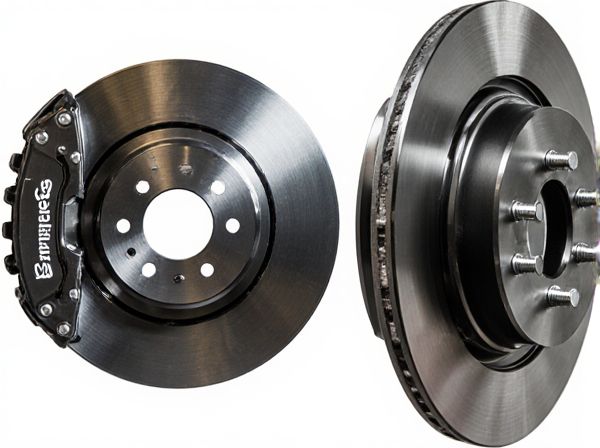
Photo illustration: Fixed Caliper vs Floating Caliper
Fixed calipers provide consistent braking force with pistons on both sides of the rotor, ensuring even pad wear and strong performance. Floating calipers have pistons on one side and move laterally, offering a simpler, lighter design that self-adjusts to rotor thickness variations. Your choice depends on the balance between braking power, weight, and maintenance preferences.
Table of Comparison
| Feature | Fixed Caliper | Floating Caliper |
|---|---|---|
| Design | Caliper is rigidly mounted, pistons on both sides of rotor | Caliper moves laterally, piston usually on one side |
| Performance | Better braking power and even pad wear | Good performance, less powerful than fixed calipers |
| Cost | Higher manufacturing and maintenance cost | Lower cost, simpler design |
| Weight | Generally heavier | Lighter weight |
| Application | High-performance, racing cars, heavy vehicles | Most passenger vehicles, everyday use |
| Maintenance | More complex, requires precise servicing | Simple, easier to maintain |
Introduction to Brake Calipers
Brake calipers are critical components in disc brake systems, responsible for applying pressure to brake pads and generating the friction needed to slow or stop a vehicle. Fixed calipers feature pistons on both sides of the rotor, providing uniform pressure and typically offering better performance in high-demand situations. Floating calipers utilize pistons on one side and slide on pins to apply even pressure, making them lighter and more cost-effective for standard braking needs.
What Is a Fixed Caliper?
A fixed caliper is a type of brake caliper that houses pistons on both sides of the rotor, applying pressure evenly from both sides for consistent braking performance. It is bolted firmly in place and does not move, offering greater rigidity and often improved stopping power compared to floating calipers. Fixed calipers are commonly found on high-performance vehicles and motorcycles due to their enhanced braking control.
What Is a Floating Caliper?
A floating caliper is a type of brake caliper that moves laterally, allowing it to self-adjust to the rotor's size and wear, improving braking efficiency. It consists of a single piston on the inboard side, which pushes the brake pad against the rotor, while the caliper housing floats to apply pressure on the opposite pad. This design offers a simpler, lighter, and cost-effective braking solution compared to fixed calipers, commonly used in passenger vehicles and some motorcycles.
Operational Differences: Fixed vs Floating Calipers
Fixed calipers house pistons on both sides of the rotor, applying even pressure simultaneously for strong, consistent braking performance. Floating calipers have pistons on one side and slide on pins to clamp the rotor, allowing slight movement to align with brake disc variations and reduce manufacturing complexity. The operational difference lies in fixed calipers providing rigid, symmetrical force, while floating calipers use lateral movement to accommodate rotor flex and wear.
Performance Comparison: Stopping Power and Heat Dissipation
Fixed calipers generally deliver superior stopping power due to their multi-piston design, which applies uniform pressure on brake pads and enhances braking efficiency. Floating calipers, while lighter and more cost-effective, often experience uneven pad wear and reduced clamping force, leading to shorter stopping distances in high-performance scenarios. Heat dissipation is more effective in fixed calipers because their rigid structure and multiple pistons allow better heat distribution, minimizing brake fade during intense or prolonged braking.
Maintenance and Durability Considerations
Fixed calipers have a simpler design with pistons on both sides of the rotor, leading to less frequent maintenance and generally higher durability under heavy use. Floating calipers, featuring a single piston and sliding mechanism, may require more regular inspection and maintenance due to potential uneven pad wear and sliding pin lubrication needs. Selecting fixed calipers enhances long-term reliability and reduces downtime in high-performance or commercial vehicle applications.
Cost Analysis: Fixed vs Floating Brake Calipers
Fixed brake calipers typically cost more due to their complex design and higher-quality materials, making them a premium choice in performance and durability. Floating calipers are generally more affordable and easier to manufacture, resulting in lower replacement and maintenance expenses while still providing reliable braking for everyday vehicles. Evaluating the total cost includes considering initial purchase price, maintenance frequency, and longevity, where fixed calipers may offer better long-term value despite the higher upfront investment.
Common Applications and Vehicle Suitability
Fixed caliper brake systems offer superior braking performance and consistency, making them ideal for high-performance sports cars and racing vehicles where precision and reliability are crucial. Floating caliper brakes provide a more cost-effective and simpler design, commonly found on everyday passenger cars and light trucks, where moderate stopping power and ease of maintenance are prioritized. Both systems are widely used across various vehicle types, with fixed calipers favored in luxury and performance models, while floating calipers dominate in mass-market, fuel-efficient vehicles.
Advantages and Disadvantages of Each Type
Fixed caliper brakes offer superior stopping power and consistent braking performance due to their rigid construction, but they tend to be heavier and more expensive to manufacture. Floating caliper brakes are lighter and easier to maintain, providing self-adjusting capabilities that reduce uneven pad wear, although they may deliver less precise braking force compared to fixed calipers. The choice between fixed and floating calipers depends on prioritizing performance consistency versus weight and maintenance convenience in braking systems.
How to Choose Between Fixed and Floating Calipers
Choosing between fixed and floating calipers depends on the application's precision requirements and budget constraints. Fixed calipers offer higher rigidity and accuracy, making them ideal for precision measurements in machining and quality control settings. Floating calipers provide versatility and cost-effectiveness, suitable for general measurements where slight flexibility is acceptable.
 caratoz.com
caratoz.com